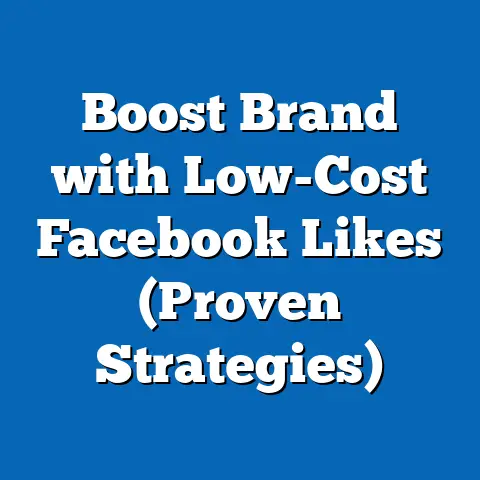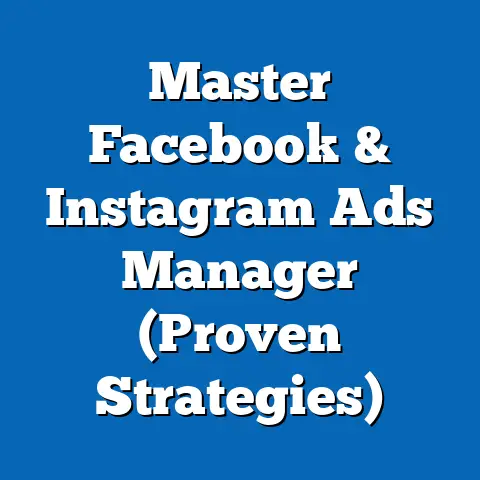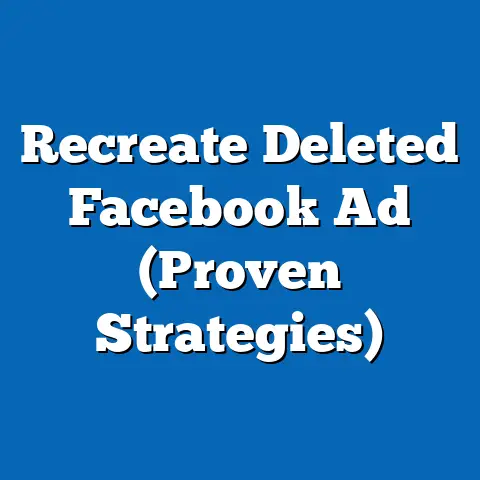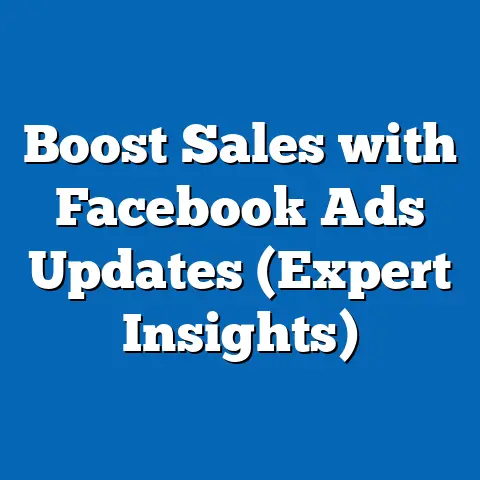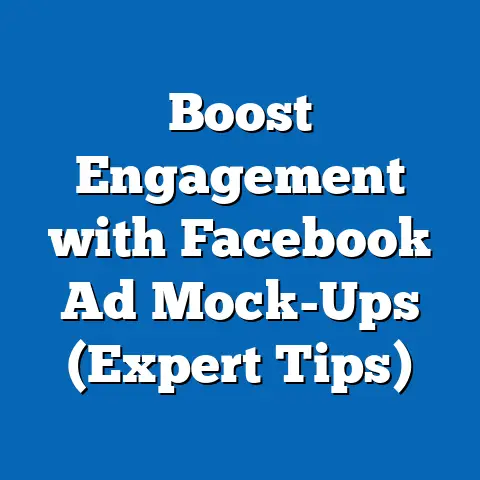Fixing Facebook Ad Errors (Ultimate Troubleshooting Guide)
Imagine you’ve just launched a highly anticipated Facebook ad campaign. You’ve poured hours into crafting the perfect copy, selecting stunning visuals, and meticulously defining your target audience. You hit the “publish” button, brimming with excitement, only to discover that your ads aren’t being shown, or worse, they’re getting rejected. The excitement quickly turns to frustration as you scramble to understand what’s gone wrong. Believe me, I’ve been there. I remember one time, I was launching a campaign for a new client, a local bakery. I had everything meticulously planned, from the mouthwatering images of their pastries to the hyper-local targeting. But the ads just wouldn’t run! It turned out I had accidentally used an image with too much text, violating Facebook’s ad policy. This seemingly small mistake cost me valuable time and delayed the campaign launch.
Facebook ads are a cornerstone of digital marketing for countless businesses. They offer unparalleled reach, precise targeting, and measurable results. But the path to successful Facebook advertising isn’t always smooth. Common errors can derail even the best-laid plans. From ad rejections and targeting mishaps to budget blunders and tracking troubles, the potential pitfalls are numerous. I’ve seen firsthand how these errors can lead to wasted budget, missed opportunities, and a general sense of marketing mayhem.
Understanding Facebook Ad Errors
Let’s start with the fundamentals. What exactly constitutes a Facebook ad error? In essence, a Facebook ad error is any issue that prevents your ad from running as intended or hinders its performance. These errors can manifest in various forms, each with its own set of causes and consequences.
I like to categorize Facebook ad errors into the following broad groups:
- Account Issues: These errors relate to the status or configuration of your Facebook ad account. Examples include payment failures, account restrictions, or violations of Facebook’s advertising policies.
- Ad Approval Problems: These errors occur when your ad doesn’t meet Facebook’s advertising guidelines and is rejected. Common reasons for rejection include inappropriate content, misleading claims, or violations of community standards.
- Targeting Mistakes: These errors arise when your ad targeting is not properly configured, resulting in your ads being shown to the wrong audience or a very small audience. This can lead to low engagement and wasted ad spend.
- Budget and Bid Complications: These errors involve issues related to your ad budget or bidding strategy. Examples include insufficient budget, incorrect bid settings, or failure to optimize bids effectively.
- Performance Tracking Errors: These errors occur when you’re unable to accurately track the performance of your ads due to issues with the Facebook Pixel or other tracking mechanisms. This can make it difficult to assess the effectiveness of your campaigns and make informed decisions.
The impact of these errors on your ad performance and overall marketing goals can be significant. Wasted budget is perhaps the most obvious consequence. Imagine spending hundreds or even thousands of dollars on ads that aren’t being shown or are being shown to the wrong people. That’s money down the drain.
But the impact goes beyond just wasted budget. Facebook ad errors can also lead to:
- Lost Opportunities: If your ads aren’t reaching the right audience, you’re missing out on potential leads, sales, and brand awareness.
- Decreased ROI: Poorly performing ads can drag down your overall return on investment, making it harder to justify your marketing spend.
- Damaged Brand Reputation: If your ads are misleading or offensive, they can damage your brand’s reputation and alienate potential customers.
- Frustration and Time Waste: Dealing with Facebook ad errors can be incredibly frustrating and time-consuming, taking away from other important marketing tasks.
I remember a small business owner who came to me absolutely defeated. He had invested a significant portion of his marketing budget into Facebook ads, but his campaigns were consistently underperforming. After a quick audit, I discovered a multitude of errors, from incorrect targeting to a poorly configured Facebook Pixel. By addressing these errors, we were able to turn his campaigns around and achieve a positive ROI.
Key Takeaway: Understanding the different types of Facebook ad errors and their potential impact is the first step towards troubleshooting and fixing them effectively.
Common Facebook Ad Errors and Their Solutions
Now, let’s get into the nitty-gritty of common Facebook ad errors and how to fix them. I’ll break down each error type and provide practical solutions you can implement right away.
1. Ad Rejection: Understanding Facebook’s Ad Policies
Ad rejection is one of the most common and frustrating issues that Facebook advertisers face. You’ve spent time crafting your ad, selecting the perfect image, and defining your target audience, only to have Facebook reject your ad for violating its advertising policies.
Facebook has strict advertising policies in place to protect its users and ensure a positive user experience. These policies cover a wide range of topics, including:
- Prohibited Content: This includes content that is illegal, discriminatory, or promotes violence or hatred.
- Restricted Content: This includes content that is sensitive or controversial, such as alcohol, gambling, or political ads. These types of ads often require special permissions or targeting restrictions.
- Misleading or Deceptive Claims: This includes ads that make false or exaggerated claims about products or services.
- Inappropriate Content: This includes content that is sexually suggestive, shocking, or disrespectful.
- Personal Attributes: This includes ads that directly or indirectly reference a person’s race, ethnicity, religion, sexual orientation, or other personal attributes.
- Grammar and Punctuation: Facebook also has rules around grammar and punctuation. Excessive use of symbols and incorrect grammar often results in rejection.
I once had an ad rejected because I used a before-and-after image that Facebook deemed to be promoting unrealistic expectations. It was a legitimate weight loss product, but the image was too dramatic. It was a hard lesson, but it taught me the importance of carefully reviewing Facebook’s advertising policies before creating any ad.
So, what do you do when your ad gets rejected? Here’s a step-by-step guide:
- Review the Rejection Reason: When your ad is rejected, Facebook will provide a reason for the rejection. This reason will typically be a reference to a specific advertising policy. Carefully review the rejection reason and the relevant advertising policy.
- Edit Your Ad: Based on the rejection reason, edit your ad to comply with Facebook’s advertising policies. This may involve changing the ad copy, replacing the image, or adjusting the targeting.
- Resubmit Your Ad: Once you’ve edited your ad, resubmit it for review. Facebook will typically review your ad within 24-48 hours.
- Appeal the Rejection: If you believe that your ad was rejected in error, you can appeal the rejection. To appeal, go to the Ad Manager and click on the “Appeal” button next to the rejected ad. You’ll be asked to provide a reason for your appeal.
Here are some additional tips for avoiding ad rejections:
- Carefully Review Facebook’s Advertising Policies: Before creating any ad, take the time to carefully review Facebook’s advertising policies. This will help you avoid common pitfalls and ensure that your ads comply with Facebook’s guidelines.
- Use High-Quality Images: Use high-quality images that are relevant to your ad and your target audience. Avoid using images that are sexually suggestive, shocking, or disrespectful.
- Write Clear and Accurate Ad Copy: Write clear and accurate ad copy that accurately describes your product or service. Avoid making misleading or deceptive claims.
- Target Your Ads Carefully: Target your ads to a relevant audience. Avoid targeting your ads to people who are likely to be offended by your ad.
- Stay Up-to-Date on Policy Changes: Facebook’s advertising policies are constantly evolving. Stay up-to-date on the latest policy changes to ensure that your ads remain compliant.
Key Takeaway: Understanding and adhering to Facebook’s advertising policies is crucial for avoiding ad rejections and ensuring that your ads are seen by your target audience.
2. Targeting Issues: Reaching the Right Audience
Targeting is the backbone of successful Facebook advertising. It’s the process of defining the specific audience that you want to see your ads. If your targeting is off, your ads will be shown to the wrong people, resulting in low engagement, wasted ad spend, and ultimately, poor results.
Common targeting mistakes include:
- Overly Broad Audiences: Targeting too broad of an audience can result in your ads being shown to people who are not interested in your product or service. This can lead to low engagement and wasted ad spend.
- Overly Narrow Audiences: Targeting too narrow of an audience can result in your ads not being seen by enough people. This can limit your reach and prevent you from achieving your marketing goals.
- Incorrect Demographics: Targeting the wrong demographics, such as age, gender, or location, can result in your ads being shown to people who are not likely to be your customers.
- Irrelevant Interests: Targeting irrelevant interests can result in your ads being shown to people who are not interested in your product or service.
- Ignoring Custom Audiences: Custom Audiences allow you to target people who have already interacted with your business, such as website visitors, email subscribers, or existing customers. Ignoring Custom Audiences can result in you missing out on valuable opportunities to re-engage with your audience.
I remember working with a client who was selling high-end baby strollers. Initially, they were targeting parents with children under the age of 2, which seemed logical. However, after analyzing their customer data, we discovered that their ideal customers were actually affluent parents who were interested in luxury brands and eco-friendly products. By refining their targeting to focus on these interests, we were able to significantly improve their ad performance.
Here are some troubleshooting tips for fixing targeting issues:
- Use Audience Insights: Facebook’s Audience Insights tool provides valuable information about your target audience, including their demographics, interests, behaviors, and more. Use Audience Insights to research your target audience and refine your targeting.
- A/B Test Your Targeting: A/B testing allows you to test different targeting options to see which ones perform best. Create multiple ad sets with different targeting options and compare their performance to see which ones are most effective.
- Refine Your Targeting Based on Performance: Regularly review your ad performance and refine your targeting based on the results. If you’re seeing low engagement from a particular segment of your audience, consider removing them from your targeting.
- Use Custom Audiences: Create Custom Audiences to target people who have already interacted with your business. This can be a highly effective way to re-engage with your audience and drive conversions.
- Layer Your Targeting: Layering your targeting allows you to combine multiple targeting options to create a more specific audience. For example, you could target parents with children under the age of 2 who are also interested in eco-friendly products.
Key Takeaway: Precise targeting is essential for successful Facebook advertising. By avoiding common targeting mistakes and using the troubleshooting tips above, you can ensure that your ads are reaching the right audience and achieving your marketing goals.
3. Budget and Bid Problems: Maximizing Ad Spend
Your budget and bidding strategy are critical components of your Facebook ad campaigns. They determine how much you spend on your ads and how aggressively you bid for ad placements. If your budget is too low or your bidding strategy is not optimized, you may not be able to reach your target audience or achieve your desired results.
Common budget and bid problems include:
- Insufficient Budget: If your budget is too low, you may not be able to reach enough people to achieve your marketing goals.
- Incorrect Bid Settings: Incorrect bid settings can result in you overpaying for ad placements or not winning enough auctions.
- Not Understanding Automatic vs. Manual Bidding: Facebook offers both automatic and manual bidding options. Not understanding the difference between these options can lead to suboptimal bidding decisions.
- Failing to Monitor and Adjust Bids: Failing to monitor and adjust your bids regularly can result in you overpaying for ad placements or missing out on valuable opportunities.
I once worked with a client who was running a very successful Facebook ad campaign. However, they were only allocating a small budget to the campaign, which limited their reach. By increasing their budget, we were able to significantly increase their reach and drive even more conversions.
Here are some solutions for optimizing your budget and bidding strategy:
- Determine Your Budget Based on Your Goals: Determine your budget based on your marketing goals and the cost of reaching your target audience. Consider factors such as your target audience size, the competition in your industry, and your desired return on investment.
- Understand Automatic vs. Manual Bidding: Understand the difference between automatic and manual bidding and choose the option that is best suited for your goals and experience level. Automatic bidding is a good option for beginners, while manual bidding offers more control for experienced advertisers.
- Set Realistic Bids: Set realistic bids based on the value of your target audience and the competition in your industry. Avoid setting bids that are too low, as this may result in you not winning enough auctions.
- Monitor and Adjust Bids Regularly: Monitor your ad performance regularly and adjust your bids based on the results. If you’re seeing low engagement, consider increasing your bids. If you’re overpaying for ad placements, consider decreasing your bids.
- Use Budget Optimization Features: Facebook offers budget optimization features that can help you automatically optimize your budget across multiple ad sets. Consider using these features to improve your overall campaign performance.
Key Takeaway: Optimizing your budget and bidding strategy is crucial for maximizing your ad spend and achieving your marketing goals. By understanding the common problems and using the solutions above, you can ensure that you’re getting the most out of your Facebook ad campaigns.
4. Ad Delivery Issues: Why Your Ads Aren’t Showing
You’ve created a compelling ad, defined your target audience, and set your budget, but your ads still aren’t showing. This can be a frustrating experience, but there are several factors that can lead to low ad delivery.
Common factors that can lead to low ad delivery include:
- Audience Saturation: Audience saturation occurs when you’ve shown your ads to the same audience too many times. This can lead to ad fatigue and decreased engagement.
- Ad Fatigue: Ad fatigue occurs when your audience becomes tired of seeing the same ad. This can lead to decreased engagement and lower ad delivery.
- Low Bid: If your bid is too low, you may not be winning enough auctions to achieve your desired delivery.
- Low Ad Quality: Facebook prioritizes ads that are relevant and engaging. If your ad has low quality scores, it may not be shown as often.
- Policy Violations: Even if your ad has been approved, it may still be subject to limited delivery if it violates Facebook’s advertising policies.
I remember a campaign I ran for a local restaurant that was struggling to get any traction. After some digging, I realized that we had been targeting the same small group of people for weeks, leading to severe ad fatigue. By expanding our audience and refreshing the ad creative, we were able to significantly improve the ad delivery and drive more customers to the restaurant.
Here are some strategies to boost your ad delivery rates:
- Refresh Your Creatives: Regularly refresh your ad creatives to avoid ad fatigue. Try using different images, videos, and ad copy.
- Expand Your Targeting: Expand your targeting to reach new people who haven’t seen your ads before.
- Increase Your Bid: Increase your bid to win more auctions and improve your ad delivery.
- Improve Your Ad Quality: Improve your ad quality by creating relevant and engaging ads that resonate with your target audience.
- Review Your Targeting: Make sure your targeting is still relevant and accurate. If your target audience has changed, adjust your targeting accordingly.
- Check for Policy Violations: Double-check your ad to make sure it doesn’t violate any of Facebook’s advertising policies.
Key Takeaway: Low ad delivery can be a frustrating issue, but by understanding the common causes and implementing the strategies above, you can boost your delivery rates and reach more of your target audience.
5. Performance Tracking Errors: Analyzing Ad Effectiveness
Performance tracking is essential for measuring the effectiveness of your Facebook ad campaigns and making informed decisions about your marketing spend. However, common tracking errors can make it difficult to accurately assess your ad performance.
Common tracking errors include:
- Pixel Misconfiguration: The Facebook Pixel is a small piece of code that you install on your website to track website conversions and other events. If the Pixel is not installed correctly, you may not be able to accurately track your ad performance.
- Attribution Issues: Attribution is the process of assigning credit for a conversion to a specific ad or marketing channel. If your attribution settings are not configured correctly, you may not be able to accurately track which ads are driving conversions.
- Data Delays: There can be delays in the reporting of ad performance data, which can make it difficult to make timely decisions.
- Inaccurate Data: Inaccurate data can result from a variety of factors, including tracking errors, user privacy settings, and data sampling.
I once worked with a client who was convinced that their Facebook ads were not working. However, after auditing their tracking setup, I discovered that their Facebook Pixel was not installed correctly on their website. As a result, they were not tracking any of their website conversions. Once we fixed the Pixel, they were able to accurately track their ad performance and saw a significant improvement in their ROI.
Here are detailed instructions on how to set up Facebook Pixel correctly and interpret analytics to gauge ad performance:
- Install the Facebook Pixel:
- Go to the Facebook Events Manager.
- Select the Pixel tab and click “Create Pixel.”
- Name your Pixel and click “Continue.”
- Choose how you want to install the Pixel code: manually, using a partner integration, or email instructions to a developer.
- Follow the instructions to install the Pixel code on your website.
- Verify Pixel Installation:
- Use the Facebook Pixel Helper Chrome extension to verify that the Pixel is installed correctly on your website.
- Check the Events Manager to see if the Pixel is firing correctly.
- Set Up Standard Events:
- Standard Events are predefined actions that you can track on your website, such as “PageView,” “AddToCart,” and “Purchase.”
- Use the Facebook Events Setup Tool to set up Standard Events on your website.
- Create Custom Conversions:
- Custom Conversions allow you to track specific actions on your website that are not covered by Standard Events.
- Create Custom Conversions based on specific URLs or events on your website.
- Interpret Analytics:
- Use the Facebook Ads Manager to track your ad performance and analyze your results.
- Pay attention to key metrics such as impressions, reach, clicks, conversions, and cost per conversion.
- Use the data to make informed decisions about your budget, targeting, and ad creative.
- Go to the Facebook Events Manager.
- Select the Pixel tab and click “Create Pixel.”
- Name your Pixel and click “Continue.”
- Choose how you want to install the Pixel code: manually, using a partner integration, or email instructions to a developer.
- Follow the instructions to install the Pixel code on your website.
- Use the Facebook Pixel Helper Chrome extension to verify that the Pixel is installed correctly on your website.
- Check the Events Manager to see if the Pixel is firing correctly.
- Standard Events are predefined actions that you can track on your website, such as “PageView,” “AddToCart,” and “Purchase.”
- Use the Facebook Events Setup Tool to set up Standard Events on your website.
- Custom Conversions allow you to track specific actions on your website that are not covered by Standard Events.
- Create Custom Conversions based on specific URLs or events on your website.
- Use the Facebook Ads Manager to track your ad performance and analyze your results.
- Pay attention to key metrics such as impressions, reach, clicks, conversions, and cost per conversion.
- Use the data to make informed decisions about your budget, targeting, and ad creative.
Key Takeaway: Accurate performance tracking is crucial for measuring the effectiveness of your Facebook ad campaigns. By setting up the Facebook Pixel correctly and interpreting your analytics, you can make informed decisions about your marketing spend and optimize your campaigns for success.
Advanced Troubleshooting Techniques
Now that we’ve covered the most common Facebook ad errors and their solutions, let’s delve into some advanced troubleshooting techniques. These strategies can help you diagnose and fix more complex issues that may not be immediately apparent.
One of the most valuable tools at your disposal is Facebook’s Ads Manager diagnostic tools. These tools provide insights into the performance of your ads and can help you identify potential problems. I often use the “Delivery Insights” feature to understand why an ad set might be underperforming. It gives a detailed breakdown of factors like audience overlap, auction competition, and ad fatigue.
Here are some advanced troubleshooting techniques:
- Use Facebook’s Ads Manager Diagnostic Tools: Facebook’s Ads Manager provides a variety of diagnostic tools that can help you identify potential problems with your ads. These tools include the Delivery Insights, Ad Relevance Diagnostics, and the Learning Phase.
- Regularly Review Performance Metrics: Regularly review your ad performance metrics, such as impressions, reach, clicks, conversions, and cost per conversion. Look for trends and patterns that may indicate potential problems.
- Make Data-Driven Adjustments: Based on your performance metrics, make data-driven adjustments to your budget, targeting, and ad creative. Don’t be afraid to experiment with different options to see what works best.
- Use Facebook’s Business Help Center: Facebook’s Business Help Center provides a wealth of information about Facebook advertising, including troubleshooting guides, FAQs, and contact information for support.
- Join Marketing Forums: Join marketing forums and online communities to connect with other Facebook advertisers and share your experiences. You can often find valuable insights and solutions to your problems by learning from others.
I remember being stumped by a sudden drop in conversions on a campaign. I checked everything I could think of – targeting, budget, ad copy – but couldn’t find the culprit. Finally, I posted my issue in a Facebook advertising group, and another marketer pointed out that there had been a recent update to Facebook’s attribution model that could be affecting my results. This simple piece of information helped me re-evaluate my data and make the necessary adjustments.
Key Takeaway: Advanced troubleshooting requires a combination of technical skills, analytical thinking, and a willingness to learn from others. By using Facebook’s diagnostic tools, regularly reviewing performance metrics, and engaging with the marketing community, you can overcome even the most challenging ad errors.
Conclusion
Navigating the world of Facebook advertising can feel like traversing a minefield. Errors are inevitable, and they can be incredibly frustrating. But I hope this guide has empowered you with the knowledge and tools you need to troubleshoot and fix those errors effectively.
Remember, understanding and addressing Facebook ad errors is not a one-time task; it’s an ongoing process. The Facebook advertising landscape is constantly evolving, with new features, policies, and best practices emerging all the time. To stay ahead of the curve, you need to be vigilant, experiment with different approaches, and adapt your strategies as needed.
I encourage you to approach your Facebook ads with a problem-solving mindset. Don’t be afraid to dig deep, explore different solutions, and learn from your mistakes. Leverage the insights provided in this guide to optimize your campaigns and achieve success in the ever-evolving world of digital advertising.
And remember, you’re not alone! The Facebook advertising community is vast and supportive. Don’t hesitate to reach out to other marketers, join online forums, and ask for help when you need it. We’re all in this together, and by sharing our knowledge and experiences, we can all become better advertisers.
So, go forth and conquer those Facebook ad errors! I’m confident that with the right knowledge, skills, and mindset, you can achieve your marketing goals and unlock the full potential of Facebook advertising.

